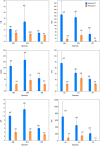The effect of shrubs admixture in pine forest stands on soil bacterial and fungal communities and accumulation of polycyclic aromatic hydrocarbons
- PMID: 37783867
- PMCID: PMC10545714
- DOI: 10.1038/s41598-023-43925-x
The effect of shrubs admixture in pine forest stands on soil bacterial and fungal communities and accumulation of polycyclic aromatic hydrocarbons
Abstract
Polycyclic aromatic hydrocarbons (PAHs) are a group of persistent toxic pollutants. The species composition of the stand is important in shaping the quality of soil organic matter and, consequently, the PAH content. The main purpose of the research was to determine the role of shrubs in shaping PAH accumulation in forest soils. The study covered the soils of the pine stands of the Rybnik Forest District, which experiences some of the highest deposition of industrial emissions in Europe. Pine stands with admixture of shrubs (alder buckthorn Frangula alnus and European hazelnut Coryllus avellana) growing in the same soil conditions were selected for the study. Samples for analyses were collected from the organic horizon (O) (from a depth of 0-7 cm) and humus mineral horizon (A) (from a depth of 7-15 cm). The organic C and total N concentrations, pH, alkaline cation content, soil enzyme activity and PAH content were determined. Additionally, the taxonomic composition of soil bacterial and fungal communities was determined. The highest activity of enzymes was noted in soils under influence of shrubs. The enzymatic activity was positively correlated with the content of total N, organic C, pH H2O and KCl and negatively with the C/N ratio. The highest PAH content was recorded in the soils of pine stands without the admixture of shrubs. Our research indicates the importance of shrubs in shaping the properties of surface horizons of forest soil and, consequently on the accumulation of PAHs. Shrubs stimulate biochemical activity of soils which results in lower PAHs accumulation by providing more easily decomposable organic matter.
© 2023. Springer Nature Limited.
Conflict of interest statement
The authors declare no competing interests.
Figures








References
-
- Jandl RM, Lindner M, Vesterdal L, Bauwens B, Baritz R, Hagedorn F, Johnon DW, Minkkinen K, Byrne KA. How strongly can forest management influence soil carbon sequestration? Geoderma. 2007;137:253–268.
-
- Richards AE, Forrester DI, Bauhus J, Scherer-Lorenzen M. The influence of mixed tree plantations on the nutrition of individual species: A review. Tree Physiol. 2010;30:1192–1208. - PubMed
-
- Pretzsch H, del Rio M, Schütze G, et al. Mixing of Scots pine (Pinus sylvestris L.) and European beech (Fagus sylvatica L.) enhances structural heterogeneity, and the effect increases with water availability. Forest Ecol. Manage. 2016;373:149–166.
-
- Błońska E, Klamerus-Iwan A, Lasota J, Gruba P, Pach M, Pretzsch H. What Characteristics of soil fertility can improve in mixed stands of scots pine and European beech compared with monospecific stands? Commun. Soil Sci. Plant Anal. 2018;49:237–247.
-
- Wenzel A, Rajot JL, Herbrig C. Influence of shrubs on soil characteristic and their function in Sahelian Agro-ecosystem in semi-arid Niger. J. Arid Environ. 2000;44:383–398.
Publication types
MeSH terms
Substances
LinkOut - more resources
Full Text Sources

